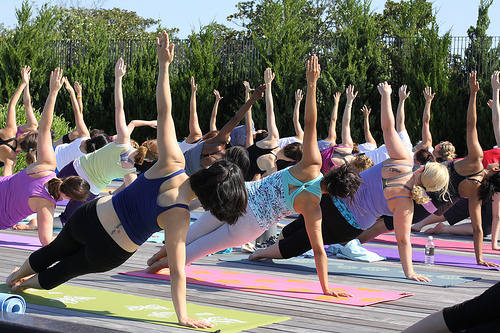After graduating from even the most thorough of teacher trainings, launching into yoga instruction can feel very intimidating.
When a brand new beginner walks through the door it can feel downright scary, especially if you’ve grown accustomed to teaching higher level classes.
Here are a few tips for teaching new yogis!
1. Reacquaint yourself with the beginner’s mind.
Any number of things could be running on a loop for a newbie: “Where should I put my mat? What if I can’t do the poses? What are we going to do with this strap?”
Do you remember the feeling you had walking into your first yoga class? If your early yoga experiences are still vivid in your memory, you shouldn’t have a problem helping your beginners feel as comfortable as possible.
2. Props and modifications are a beginner’s best friend.
The more ways you know how to make a pose accessible to all body types (with all kinds of injuries), you will become a sought after teacher. To expand your knowledge base, try to find workshops that focus on therapeutics, adjustments, how to use props, etc.
3. Be mindful of how often you’re adjusting new students.
If you’ve just learned someone’s name 10 minutes ago, avoid bombarding them with verbal and physical adjustments.
Everyone responds differently to one-on-one attention in a public class. Often, new students feel embarrassed that the whole class just witnessed “what they did wrong.” On the opposite end of the spectrum, some students are too eager for corrections and will attempt to monopolize your time.
Rule of thumb: direct as many verbal adjustments as possible to the entire group to cut down on the amount of individual cues you’re dishing out. Consider limiting the amount of times you touch a student to three adjustments in their first class. If they’re not in danger of injury, leave them be.
4. Keep it simple.
Use Sanskrit sparingly, or at least make sure you consistently offer the English translation.
Make sure your instructions are clear and concise.
Our job is to demystify the practice and make it inclusive. Fancy wording and esoteric concepts won’t win over new yogis.
5. Connect with your new students after class.
Casually inquire about how the class went for them. Let them know that breath awareness and poses come more naturally over time, and that if this class wasn’t their cup of tea, there are so many different styles of yoga to explore with a myriad of teachers to learn from.
Get the point across that the practice of yoga expands far beyond this single experience.
6. Find subtle ways throughout your sequence to explain that yoga is not just about poses.
The poses help us become stronger and more flexible— these benefits are inevitable with a consistent practice. Ask your students where they can place their attention (intention) to create more meaning beyond the physical. Emphasizing conscious breath is always a good place to start.
7. Stay confident!
You have so much to offer new students. It’s easy to get hung up on what we don’t know and forget about the significant amount (200-500 hours+!) of training that we actually have under our belts. Strive for a good mix of welcoming compassion and confidence, and beginners will trust you to lead them through a safe and doable practice.
Teaching beginners is a delicate and important job. Facilitating a class that inspires a beginner to come back should be a high priority. After all, isn’t that why you wanted to teach yoga in the first place? To share with as many souls as possible the amazing feeling that yoga brings?
Get out there and embrace the beginner!
Love elephant and want to go steady?
Sign up for our (curated) daily and weekly newsletters!
Apprentice Editor: Guenevere Neufeld / Editor: Travis May
Photo: Eli Christman / Flickr







Read 0 comments and reply